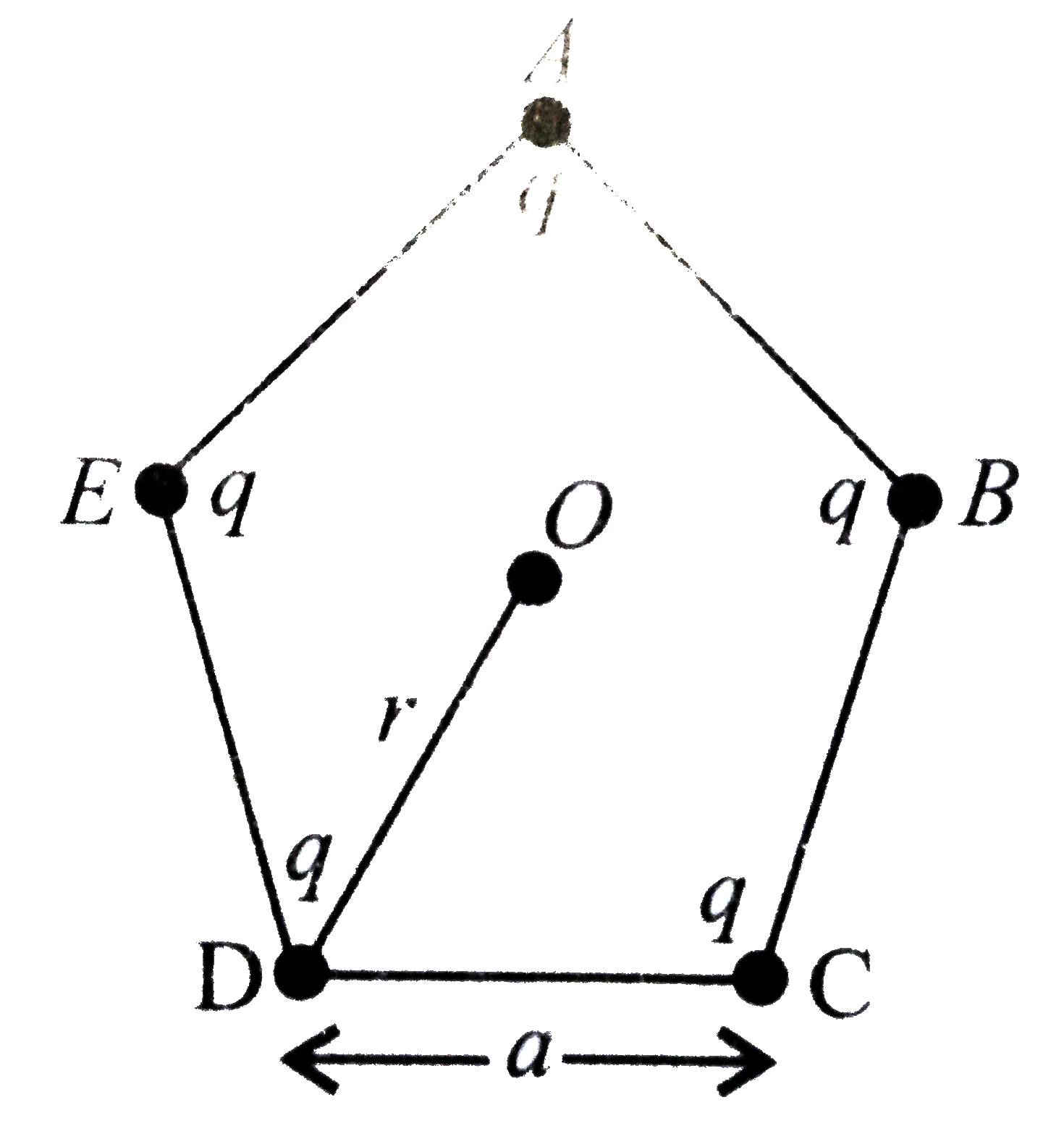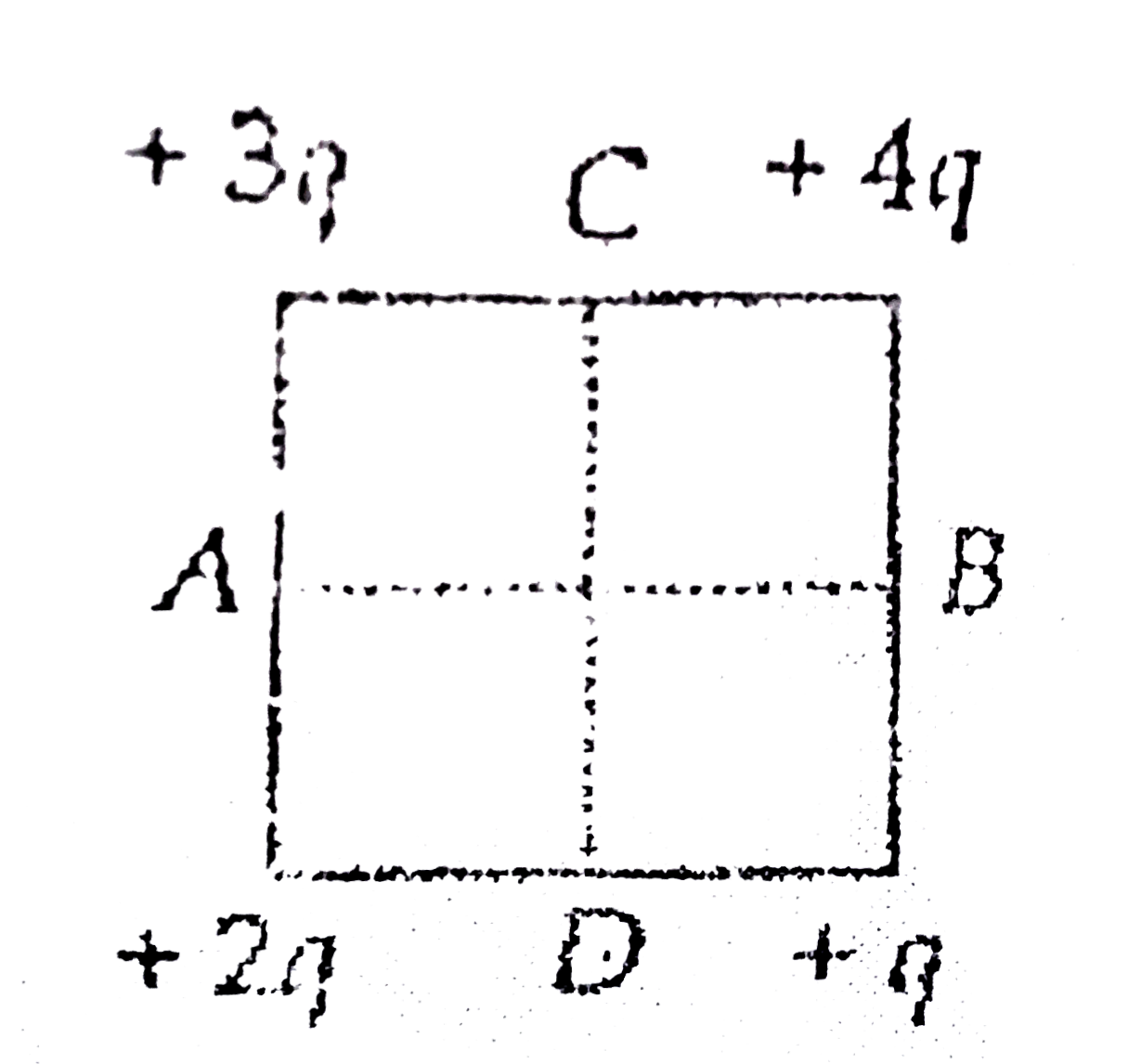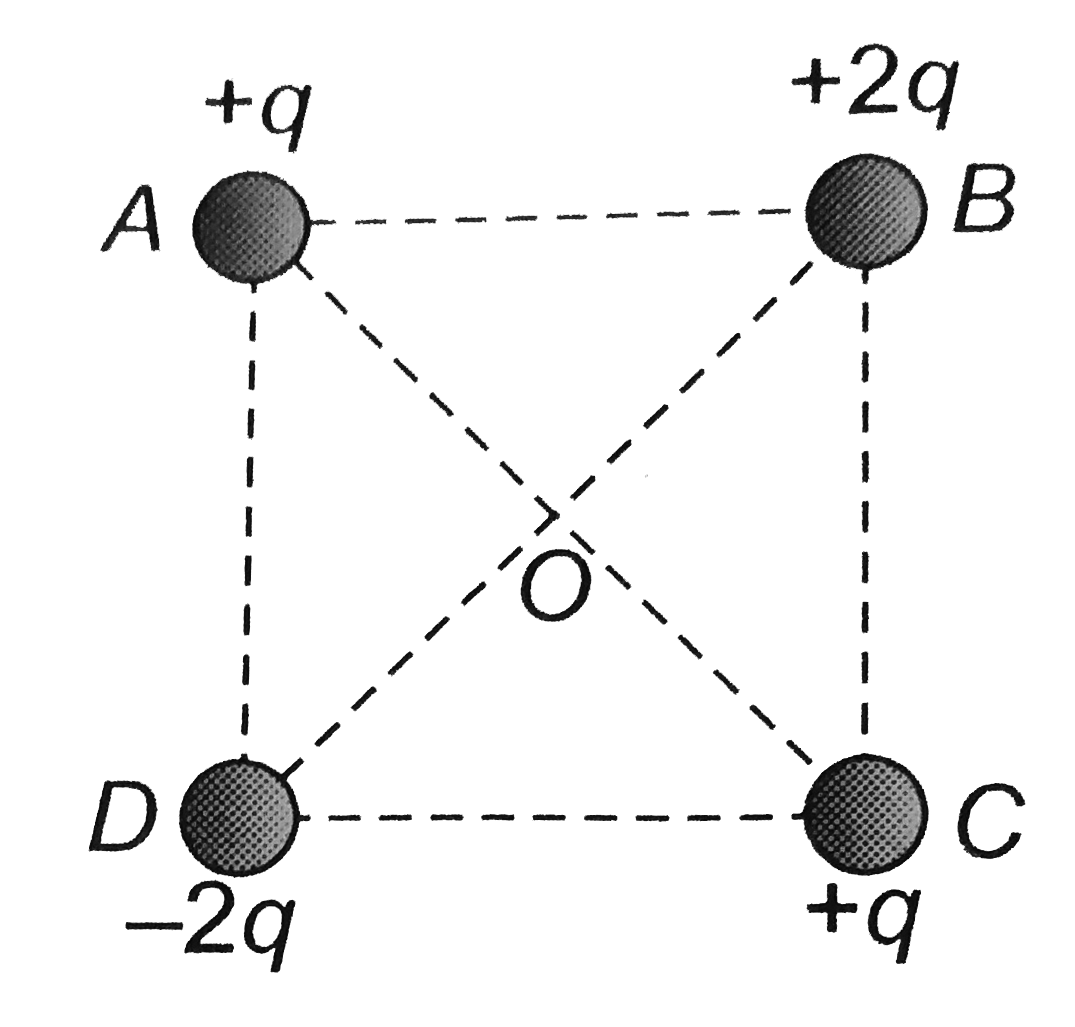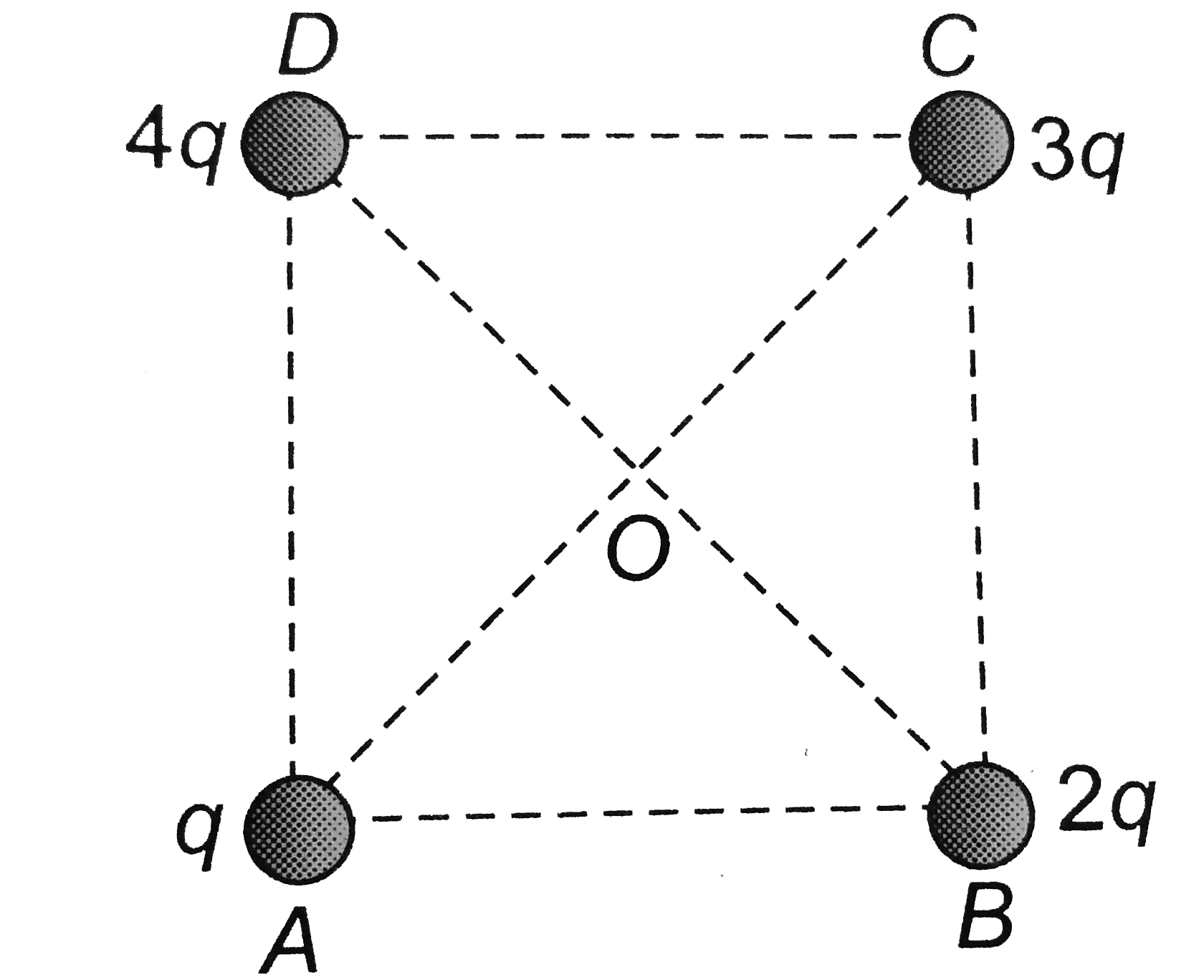Three charges each of are the corners B, C, D of a square ABCD of side 1m. The electric field at the centre .O. of the square is
towards A
towards C
towards A
towards C
The correct Answer is:A
To find the electric field at the center O of the square ABCD with three charges of +4 µC located at corners B, C, and D, we can follow these steps:
Step 1: Understand the Configuration
We have a square ABCD with side length 1 m. The charges are placed at corners B, C, and D. The center O of the square is equidistant from all corners.
Step 2: Determine the Distance from the Center to the Corners
The distance from the center O to any corner (like B, C, or D) can be calculated using the formula for the diagonal of a square. The diagonal (d) of a square with side length a is given by:
d=a√2
Since we want the distance from the center to a corner, we take half of the diagonal:
r=d2=a√22
Substituting a=1m:
r=1⋅√22=√22m
Step 3: Calculate the Electric Field Due to Each Charge
The electric field (E) due to a point charge is given by:
E=k⋅|q|r2
where k is Coulomb's constant (9×109N m2/C2), q is the charge, and r is the distance from the charge to the point where we are calculating the field.
For each charge of +4μC=4×10−6C:
E=9×109⋅4×10−6(√22)2
Calculating r2:
r2=(√22)2=24=12
Thus, substituting r2 into the electric field equation:
E=9×109⋅4×10−612=9×109⋅8×10−6=72×103N/C
Step 4: Determine the Direction of the Electric Fields
- The electric field due to charge at B points away from B towards the center O.
- The electric field due to charge at C points away from C towards the center O.
- The electric field due to charge at D points away from D towards the center O.
Step 5: Analyze the Electric Fields at the Center
The electric fields due to charges at B and C will cancel each other out because they are equal in magnitude but opposite in direction. Therefore, we only need to consider the electric field due to charge D.
Step 6: Resultant Electric Field at the Center
The resultant electric field at point O is simply the electric field due to charge D:
Enet=ED=72×103N/C
This electric field will be directed towards point A (the opposite corner of D).
Conclusion
The electric field at the center O of the square is:
E=72×103N/Ctowards A
We have a square ABCD with side length 1 m. The charges are placed at corners B, C, and D. The center O of the square is equidistant from all corners.
The distance from the center O to any corner (like B, C, or D) can be calculated using the formula for the diagonal of a square. The diagonal (d) of a square with side length a is given by:
d=a√2
Since we want the distance from the center to a corner, we take half of the diagonal:
r=d2=a√22
Substituting a=1m:
r=1⋅√22=√22m
The electric field (E) due to a point charge is given by:
E=k⋅|q|r2
where k is Coulomb's constant (9×109N m2/C2), q is the charge, and r is the distance from the charge to the point where we are calculating the field.
E=9×109⋅4×10−6(√22)2
Calculating r2:
r2=(√22)2=24=12
Thus, substituting r2 into the electric field equation:
E=9×109⋅4×10−612=9×109⋅8×10−6=72×103N/C
- The electric field due to charge at B points away from B towards the center O.
- The electric field due to charge at C points away from C towards the center O.
- The electric field due to charge at D points away from D towards the center O.
The electric fields due to charges at B and C will cancel each other out because they are equal in magnitude but opposite in direction. Therefore, we only need to consider the electric field due to charge D.
The resultant electric field at point O is simply the electric field due to charge D:
Enet=ED=72×103N/C
This electric field will be directed towards point A (the opposite corner of D).
The electric field at the center O of the square is:
E=72×103N/Ctowards A
Topper's Solved these Questions
- ELECTRIC CHARGES AND FIELDSBook:AAKASH SERIESChapter:ELECTRIC CHARGES AND FIELDSExercise:Exercise-II
Explore 56 Videos
- DUAL NATURE OF RADIATION AND MATTERBook:AAKASH SERIESChapter:DUAL NATURE OF RADIATION AND MATTERExercise:PRACTICE EXERCISEX
Explore 42 Videos
- ELECTRIC FIELD AND POTENTIALBook:AAKASH SERIESChapter:ELECTRIC FIELD AND POTENTIALExercise:PROBLEMS (LEVEL-II)
Explore 26 Videos
Similar Questions
Charges 5μC,−2μC,3μCand−9μC are placed at the corners A,B,C and D of a square ABCD of side 1m. The net electric potential at the centre of th square is
View SolutionFive equal charges each of value q are placed at the corners of a regular pentagon of side a. The electric field at the centre of the pentagon is

View SolutionFour charges are arranged at the corners of a square as shown in the figure. The direction of electric field at the centre of the square is along

View SolutionFour equal masses (each of mass M) are placed at the corners of a square of side a. The escape velocity of a body from the centre O of the square is
View SolutionFour charges of same magnitude q are placed at four corners of a square of side a . The value electric potential at the centre of the souare will be (where k = 14πε0 )
View SolutionThree charges, each equal to q, are placed at the three. corners of a square of side a . Find the electric field at. the fourth corner.
View SolutionThree charges, each equal to q, are placed at the three. corners of a square of side a . Find the electric field at. the fourth corner.
View SolutionFour charges are arranged at the corners of a square ABCD, as shown. The force on a positive charge kept at the centre of the square is

(A)zero (B)along diagonal AC
(C)along diagonal BD (D)perpendicular to the side AB
View SolutionCharges q,2q,3q and 4q are placed at the corners A,B,C and D of a square as shown in the following figure. The directon of electric field at the centre of the square is along

View SolutionCharges q,2q,3q and 4q are placed at the corners A,B,C and D of a square as shown in the following figure. The directon of electric field at the centre of the square is along

View Solution